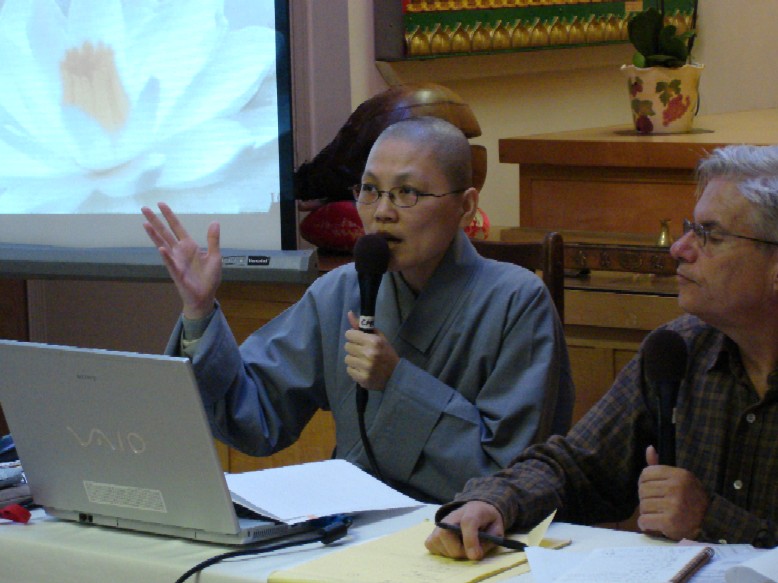
Lotus Sutra 1 of 8
10/05/2008
Report by Ling Yun and Chang Jie
 NEW YORK – On October 12, during the Sunday Open House, Venerable Guo Chuan started an
8 week series of dharma talks on the Lotus Sutra. NEW YORK – On October 12, during the Sunday Open House, Venerable Guo Chuan started an
8 week series of dharma talks on the Lotus Sutra.
Venerable gave a general introduction on the importance of the Lotus Sutra in Buddhism,
what the sutra is about, and how the sutra is viewed in the Buddhist world.
Within Buddhist history, only two sutras are quoted as "king of sutras" – one is the
Lotus Sutra and the other is the Avatamsaka (or the Flower Ornament) Sutra. It is
said that one will never know how much compassion the Buddha has for sentient beings
until one reads the Lotus Sutra and one will never know how much treasure the Buddha
has until one reads the Avatamsaka Sutra.
Master Sheng Yen has remarked that the Lotus Sutra is one of the two sutras that
have had the most influence on his practice. During his six-year solitary retreat,
he prostrated to every character of the sutra, about 69,630 characters in all.
The term "dharma drum" comes from the Lotus Sutra; the name of Master Sheng Yen's
organization, Dharma Drum Mountain comes from this term.

According to Venerable, the sutra is about the one great reason Buddha came to
this world, to help all beings eventually attain the great wisdom that the
Buddha has. The Buddha used countless numbers of expedient means, various
explanations of causes and conditions, and various similes and parables in
order to expound doctrines to all beings.
The sutra was first spread orally and was later recorded in an Indian language
on leaves or silk which were only to be lost. The current sutra is based on
Luo Shi's translation in 406 CE. The sutra is recognized for three great contributions:
1. Anyone that recites "Namo Buddha" can attain buddhahood
2. Faith in Bodhisattva Avalokitesvara (Guan Yin)
3. The establishment of the Tian-tai school
Ven. Guo Chuan said that by looking at the history of the recording of the
sutra, we may be able to sincerely appreciate the compassion and efforts of
the Buddha and the many dharma practitioners who have made it possible for
us to learn the sutra. She advised everyone that the foundation of practice
is to establish faith in Buddhism, to develop a great vow, and to continue
practicing. Every one of us is like a baby bodhisattva; we may fall along
the path of the practice, but as long as we have faith, we can achieve buddhahood.
|